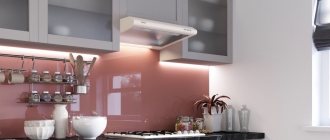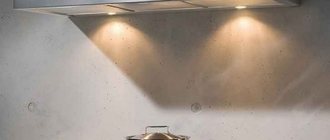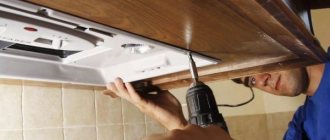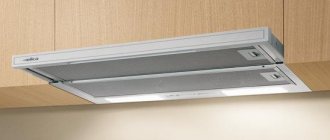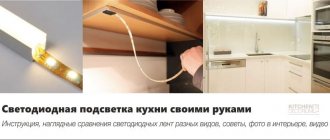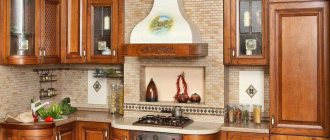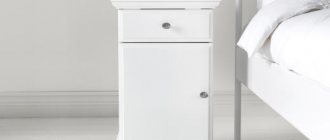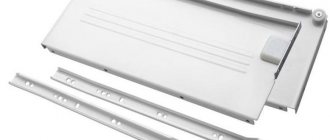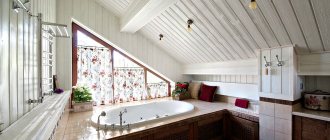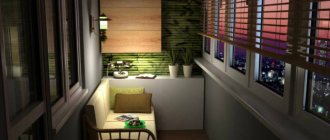A hood is a mandatory attribute in any kitchen, which allows you to comply with all the standards for arranging ventilation in a residential area. Most often, the devices are connected to the general house exhaust system, but in some cases this is not possible, then the only option left is with recirculation or coal ventilation. Kitchen hoods without a ventilation outlet are beginning to enjoy some popularity due to their autonomy and the ability to be installed in any room.
Typical ventilation schemes in the kitchen
During installation, three main schemes for kitchen ventilation are used:
- Natural - ventilation is carried out using special common house ventilation ducts to remove steam, and holes and vents through which air from the street enters the room. This does not require the installation of hoods or other devices.
- Forced - air circulation is provided by a non-volatile device that rotates fans to create air flow movement.
- Combined - it combines natural and forced ventilation schemes, when air enters the room independently, and smoke and steam are removed using special kitchen hoods. They can expel air into the ventilation shaft or purify the air inside themselves using special filters.
The main advantage of natural ventilation is a comfortable indoor microclimate. The air is replaced on its own, and no investment is required; just open a window, vent or balcony. But it also has a serious drawback - low efficiency. When cooking, when a large amount of steam, smoke and burned fat is released, the intervening air flow does not have time to cope with the removal of heavy odors that remain in the room for a long time.
To solve this problem, high-performance forced ventilation devices are installed. But such hoods only work when connected to the mains, because... It is impossible to start the fans without generating electricity.
To combine the advantages of both ventilation options, a combined scheme was invented. Small smoke is removed by natural ventilation, and during long cooking periods the hood is turned on to help clean the air.
Question No. 8. For what cases is this ideal?
The main reason to install a recirculating hood is the inability to vent polluted air into the shaft or outside. There are several reasons for this:
- the mine is too far from the intended installation site of the hood, and there is no desire to build labyrinthine paths from corrugated paper;
- there is a shaft, but there are problems with the ventilation, for example, all the air with aromas gets to the neighbors;
- there is no shaft at all or there is no hole in the kitchen;
- the presence of reverse draft in ventilation (for example, when gas boilers or water heaters are installed) - the use of a standard hood here increases the risk of carbon monoxide poisoning;
- The air duct does not fit into the design.
The conclusion suggests itself is the following: a hood without an outlet should be chosen only if there is no possibility of making a hood with an outlet, since the latter is much more efficient and has a simpler operating mechanism.
Types of hoods without venting
When comparing the two types of hoods, the version with ventilation has the greatest number of advantages. The main reason is increased performance, which allows you to move a much larger volume of air through the hood, thereby quickly clearing the room of smoke.
But not in all situations the kitchen is equipped in such a way that an exhaust device with a ventilation duct can be installed in the room. Then the only option for the owner is a type of kitchen hood without an air duct. Then air purification is carried out using recirculation, when in the kitchen the purified air remains in the room and does not go outside.
Devices can also be divided according to installation method: separately installed and built-in. The best ones are built-in ones, which take up a minimum amount of space. The cabinet needed to disguise the working unit can be used for its intended purpose, storing various kitchen utensils there.
A few more distinctive types of hoods for kitchens without an air duct, which can be used to divide hoods into groups - materials, design, capabilities. All this will directly affect the cost of the device. Another important factor that determines the price is the method of air purification. Various carbon and grease filter elements can be used.
The inflated cost may be due to the brand, release date of the model, etc. But when choosing a suitable hood, you should carefully pay attention to all these nuances, because... they allow you to reduce the cost of household appliances by a couple of times. Even a little-known manufacturer can use high-quality materials and the same technologies as a popular brand, the price of which is much higher.
Question No. 10. Is there two in one?
In fact, hoods are divided not only into two types (with and without vent). There is also a third - the most universal combined option - combining both of these modes. This technique can suck in air and discharge it into the ventilation or street, and in another mode, simply drive the air through a filter.
Such models appeared quite recently, but they are still not popular for two reasons:
- the price of such equipment is noticeably higher than analogues with one function;
- The recirculation mode is clearly inferior in efficiency to a conventional hood, so there is a chance you may even forget how to convert these modes - it will not be used.
It turns out that there is no point in a 2 in 1 hood, and there is no need to spend money on it.
Operating principle of recirculation models
If a conventional hood is built in such a way that all the air is discharged into the ventilation hole, then in the case of models without a ventilation outlet, the air is forced through a special filter, after which it enters back into the room in a purified form. The way a ductless hood works is its main advantage. There is no need for an air exhaust duct, which in some cases must be installed with the help of specialists. One of the components of smoke in the kitchen is grease. To remove it, a special grease filter is used, which is the first in the system, after which there is a carbon filter that cleans the air from other impurities. The grease filter is an external part of the equipment and is the first to meet the incoming air flow.
Next is a fine filter. It cleans the air of small particles that cannot pass through the “barrier”. Some expensive models have not 1, but several carbon filters, each of which is configured for its own level of purification. When the air is already free of impurities, it returns to the room
The exhaust system has two main working elements, thanks to which air circulates in the room: a motor and a fan. Some models are equipped with two engines at once, which allow you to capture more air, or several fans that capture air not only from below, but also from the sides. All units are located inside the housing above the filters or between them, depending on the layout of the individual model.
Motor power directly reflects the performance of the hood. All of them operate from a 220 W network. Therefore, in modern kitchen designs, an additional outlet in the kitchen is always prepared in advance, where the air purification device will be connected.
Renewing the air flow is one of the main conditions for the operation of any hood, regardless of its type. Even recirculating models require that there be a flow of fresh air into the room. The reason is that a device without exhaust only purifies the existing air, but it does not become fresher, and the amount of oxygen in it does not increase.
Filters only cope with removing vapors and large particles. Therefore, installing a recirculating hood does not eliminate the need for daily ventilation.
Advantages and disadvantages
Hoods with a carbon filter have many advantages.
They:
- They are small in size and easy to install
- support natural air circulation
- work fully without fresh air coming from outside
- low cost, despite regular filter replacement
- can be hung anywhere above the stove without being tied to ventilation
- can be built into the kitchen and will match any color and style of facades
- ideal for small kitchens
The only negative is energy consumption.
Design and features of coal exhaust
Hoods that use carbon filters to filter air have quite conflicting reviews. Some believe that they will never be able to replace full-fledged devices, but for others such equipment is ideal: there are no corrugated pipes, no additional knowledge is required for installation, etc.
Is it worth using carbon filters?
Purification is an alternative to completely replacing indoor air. Because Since the air is not interchangeable, it is necessary to use filters that purify the air like water.
Opponents use the inability of the carbon filter to cope with the task as the main argument. But at the same time, exhaust hoods without exhaust can be found in some professional restaurant kitchens, where air purification is one of the first places.
The main reason for the popularity of carbon filters is the ability to install a ventilation-free hood anywhere in the kitchen. Minimum requirements for installation and maintenance allow you to install the equipment yourself, without the help of specialists. This plus is especially relevant when equipping a room that simply does not have a suitable opening for ventilation. Such problems are common in older homes.
Another advantage is the range of models available on the market. Each client will be able to choose the equipment that is ideal for fulfilling certain purposes. A wide selection results not only in the availability of models suitable for a specific room, but also available for any budget. An unobvious advantage is the ability to retain heat during the cold season. Conventional hoods emit heated air into the ventilation, and the room is filled with cold air from the street. This problem will not happen with recirculating models, because they do not replace flows, but clean them of contaminants.
Recirculation is one of the operating modes of some standard duct-connected hoods. It allows the equipment to begin moving air inside the room without sucking it outside.
What types of carbon filters are there?
The filter is the main part that allows the exhaust hood to send air from the room to the street. Filters come in cassette and pillow form. For the most part, they are created individually for models from certain manufacturers, because each of them has its own shape, depending on the design and features of the hood. But on the market you can also find universal options that fit several popular models at once.
Various materials can be used in production. Some types of filters can even be updated, making them reusable, but this is quite rare. Coal acts as an abrasive that retains particles. It comes in 4 types:
- Peat;
- Stone;
- Coconut;
- Impregnated.
Coal is a material that has no expiration date. Therefore, it can be used even several years after stagnation. The main thing to remember is that it must be replaced periodically. The service life of one cassette will depend entirely on the frequency of switching on the equipment and the volume of air being distilled. When the performance properties are exhausted, particles from the air will not be retained in the abrasive, and the equipment itself will work in vain.
Ductless hood: main advantage
Very often, recirculation systems are lenient. Some people are completely satisfied with a ductless hood, while others are not satisfied. However, many do not even know what positive qualities such systems have.
When the hood with an air duct works, then, in principle, everything is in order. The air in the room is always clean. But what happens if the system is turned off? If the flow hood does not work, then there is a violation of natural air exchange in the room. As a result, the quality of ventilation deteriorates by about half. This occurs because the main channel is blocked by a pipe.
A hood without an air duct works on a completely different principle. When the system is turned on, air recirculation begins. When the hood is turned off, natural air exchange is not disrupted. After all, the main channel is blocked. This is the main advantage of the system. In other words, a hood without an air duct does not interfere with the natural air exchange in the room.
Technical characteristics overview
Technical characteristics are something that you need to pay attention to when purchasing any household item. Although design and construction can also play a decisive role in choosing the right device for installation in a particular kitchen, if it does not have enough power, it simply will not be able to cope with the tasks at hand.
Device performance calculation
Purchasing a hood without a ventilation outlet with excessive capacity is not a good idea. After all, all the potential for which the money was paid simply will not be revealed. But you should also not purchase a hood with insufficient performance, because over time the level of air pollution will gradually increase.
All data on the size of the kitchen for which a specific model was created is usually indicated in the technical data sheet of the product. As an example, we can take Krona Camilla 600, whose productivity is 385 m3/h - 550 m3/h, designed to work in a room of no more than 11 m2 with a ceiling height of up to 2.7 m.
You can determine productivity yourself. To do this, you will need to multiply the volume of the room by the number of recirculation cycles, taking into account the error. In the kitchen these figures are 12 and 1.3, respectively. The error coefficient is 1.3 for models with a tap, and for devices without it – 1.7.
To get an accurate indicator of the performance of a hood without exhaust ventilation for a specific kitchen, you must use the formula:
area * ceiling height * number of recirculation cycles * error = minimum hood performance
For example: 11 * 2.5 * 12 * 1.3 = 429 m³/h
Calculations show that to work in this kitchen, in which the possibility of air exhaust can be implemented, you will need a device with a minimum capacity of 429 m3/h. The Krona Camilla 600 model is ideal for this parameter.
Is noise level that important?
Another important parameter that you need to pay attention to when choosing the right equipment is the noise level. This parameter is far from the first that people pay attention to, but in vain. Apartment owners begin to think about problems with noise when they have already installed a hood in the kitchen and realized that in operating mode it makes too loud sounds. This parameter is especially important when installing the device in a studio or large kitchen, where family members spend a lot of time.
Most modern models feature sound insulation, which minimizes the amount of extraneous noise. If a coal hood is installed in the kitchen, the noise may come from a fan, motor or other moving components of the structure, even air passing through the mains.
But even the purchase of expensive equipment does not eliminate the appearance of extraneous noise. The reason is that the price is directly proportional to performance, increasing which cannot be avoided by increasing the amount of extraneous noise. Therefore, the ELICA HIDDEN HT IXGL/A/90 model, which costs more than 40 thousand rubles, has a noise level of 62 dB, like the ELICA ELITE 14 LUX GRIX/A/90 model, which costs only 14 thousand rubles.
Convenient control and adjustment
If you are constantly cooking in the apartment, then the hood is turned on daily, which means ease of control becomes the most important parameter. The devices are divided according to control options: manual and remote.
In the first case, adjustment is carried out using sliders or buttons (increasingly touch-sensitive). Such hoods without an air duct are noticeably cheaper due to the absence of the need to implement additional functions and technologies. Mid-price segment models offer the ability to control the device using a panel located on the front. The buttons are responsible for the operating mode, speed, power, backlight, filtering mode, etc.
Remote control is often found in expensive models that position themselves as “maximally convenient.” To control them, it is enough to have a remote control at hand. Despite this, all buttons are duplicated on the front panel of the hood so that each consumer can control the device in the way that is convenient for him at a particular moment.
Important Features and Options
Additional features can also be classified as “conveniences”, but still they do not become the main factor for some customers in choosing a particular model. After all, every additional function affects the cost of the device. The price is especially noticeably affected by new developments, which are found in a small number of models, and even those belong to the luxury group.
Additional functions are a place of competition for companies, because sometimes it is the ability to set a timer or automatic shutdown depending on sensor data that becomes the decisive factor in choosing a model.
Hoods from famous brands
Due to their engineering features, recirculating types of hoods do not belong to the category of very complex products; therefore, many companies are engaged in their production. But not all of them treat consumers responsibly and do not pay due attention to the quality of materials and technological processes.
Which companies meet current consumer demands?
Table. Popular models of hoods
| Name of recirculation hood | Description and brief operating characteristics |
| Low noise hood, has effective sound insulation of the mechanical compartment and the most modern sealed bearings. Touch electronic control, fan power 800 m3/hour, which is quite enough even for large kitchens. There are three main speeds of operation; in addition, you can turn on perimeter or intensive suction. LED backlight increases the attractiveness of the device, the noise level is no more than 60 dB. The disadvantages include the lack of a carbon filter. |
| A very original appearance can decorate not only kitchens; such hoods can be installed in work rooms if its owner and guests have not given up the bad habit of smoking. Designers recommend using units in modern studio kitchens. Electronically controlled hood, width 100 cm, capacity 550 cubic meters. meters. The electric motor with an extended operating hours has three speeds and an intensive mode. This mode is used to quickly clean the air in case of critical smoke pollution. An advantageous advantage is the presence of a filter contamination indicator, which simplifies its timely cleaning or replacement and increases the operating time of the unit. Disadvantage - the noise level is 75 dB, which is quite high for residential premises. |
| The hood resembles an ordinary pendant lighting fixture, and therefore can be installed in any room. It has two filters, which improves the quality of air purification. Touch control system, four operating speeds, there is a remote control. The design is improved due to halogen lighting; the fan power is 550 m3/h. Disadvantages - the carbon filter clogs relatively often; untimely replacement has a negative impact on the duration of operation, the quality of air purification and operating noise. |
| The very compact hood barely attracts attention and successfully imitates a modern lamp with LED bulbs. An air pollution control indicator tells owners when to turn on the device. The control is electronic, there is a remote control. With a capacity of up to 830 cubic meters of air per hour, the hood occupies a leading position among household units in terms of this parameter. Using a timer, automatic on/off settings can be made; there are three operating speeds and an intensive air purification mode. A noise level of 66 dB fits within the tolerance range for this type of household appliance. Disadvantages: high cost and lack of a carbon filter. |
| Built into suspended and suspended ceilings, the enclosed space further reduces operating noise. The engine power is only 220 W, which makes it possible to reduce energy losses and reduce financial costs. Height 19 cm, productivity 830 m3/h, there are three operating speeds. If you need to quickly clean the air, the intensive mode is activated. Automation allows users to configure the optimal interval mode of on/off. There is an option for air suction around the perimeter of the device, the noise level is no more than 50 dB - one of the lowest values among all types of household hoods. The disadvantage is the high cost and the lack of a carbon filter. |
| An original hood built under the countertop. The fan capacity is 960 m3/h, has four operating speeds and touch control type. Duplicated by a portable remote control. The maximum noise level does not exceed 66 dB; two filters are installed to capture grease and unpleasant odors. Disadvantage: the very high cost significantly reduces the number of potential consumers. |
Of course, these are not all models and manufacturers of hoods; the table shows only brands with world-class quality. Buy products from well-known companies; this approach will allow you to avoid many troubles.
Rules for installing a recirculation hood
Prices for the range of kitchen hoods
Hoods
Read more about extractor hood filters
The inability to remove air into ventilation prompts us to look for other ways to combat the steam and smoke generated during cooking. Filters became such a solution. Coal does an excellent job of cleaning the air from specific kitchen odors. Most often, it is placed in special removable plastic cassettes of a certain shape, which need to be changed at certain intervals depending on the frequency of air filtration.
Other filters can be used to improve cleaning. For example, to remove evaporated fat that settles on the walls of the filter and does not enter the human lungs. It looks like a metal grate or mesh and is installed in front of the coal fire.
What types of grease filters are there:
- Paper (non-woven) is a disposable option that will need to be replaced after each device is turned on;
- Organic (sintepon) - unlike paper, it can be washed to remove all the fat from the pores, but this procedure must be approached carefully so as not to damage it;
- Synthetic (acrylic) - relatively reusable products that can be adjusted to fit the dimensions of any device, while being quite durable and effective;
- Metal (aluminum or steel) are the most reliable, allowing you not to think about the upcoming replacement of the panel, because To clean it, a soft sponge and dishwashing detergent are enough.
This filtration method cannot completely remove the specific odor that appears during cooking, but it makes it possible to retain particles of dissolved fat. This filter does not require replacement; it is enough to treat it with non-abrasive means approximately once a month.
When the time comes to change the carbon filter (this happens once a quarter if the hood is used frequently), you will notice both original and non-original consumables on store shelves. The buyer chooses which ones to purchase. Before doing this, you will need to carefully study the positive and negative sides of both options. After all, it also happens that universal filters perform better than the original analogue. In addition, analog universal filters most often have a low price.
Question No. 6. Is it possible to make a carbon filter with your own hands?
Not everyone wants to spend money on expensive consumables, so the question arises what can replace them. Activated carbon from the nearest pharmacy costs a few rubles!
This option is only suitable for those filters that have real fractional carbon inside, and not a sponge or paper cloth soaked in it. In this case, the filter must be disassembled, the dirty coal must be pulled out and thrown away, and a new one must be filled in.
New coal, if it is in tablets, and not a special fractional one, it is advisable to crush it a little - the tablet can be divided into 3-4 parts.
You can do without new carbon: the second method is quite labor-intensive and is necessary only in cases where this carbon filter is no longer produced or it is impossible to find an analogue of the same diameter.
The filter must be disassembled, all the coal taken out and heated with a burner until red-hot, and allowed to cool. After this, assemble the structure back and install it in place. You can watch the video in more detail about the procedure itself, how to restore the filter and what it looks like before and after.
How to restore a kitchen hood's carbon filter.
Installation rules for the recirculation model
Before proceeding with the installation, it is necessary to remove all dimensions of the recirculation model and equip a cabinet above the stove, where the “insides” of the hood without exhaust will be hidden. It is necessary to carefully examine the strength of the base to which the equipment will be attached.
The mounting method itself may differ depending on the manufacturer and the selected model. Some hanging hoods are equipped with brackets and holders, while others are equipped with a platform and a set of metal cables.
The installation process itself takes place strictly according to the instructions. Insufficient voltage, mismatch with the horizon, and much more can cause unstable operation of the equipment. Experts identify several rules that must be taken into account when installing a kitchen hood without an outlet:
- Prepare an outlet to power the device. Most models support the standard 220W, but some models can operate at other voltages, which must be taken into account when creating a power point. It must be grounded so that during voltage surges all excess power is removed from the apartment.
- The distance between the bottom of the hood and the stove must be at least 650 mm for electric and 750 mm for gas. Some instructions may contain slightly different numbers, so you should always refer to the accompanying booklets.
- Prepare the area for the hood in advance. Typically its dimensions are 50 and 60 cm, but in some cases the devices can exceed 90 cm if they are designed to install hoods over fireplaces.
- Make room for purified air to escape.
Installation of the metal filter occurs at the last stage, when the device is ready for use. The simplest slider models are activated by simply moving the handle towards you, which opens the air duct.
Installation nuances specific to a particular model are also added. When installing the equipment yourself, you can not only carefully study the instructions, but also watch useful videos from YouTube.
Price
Prices for the simplest exhaust devices can start from 3.5 thousand rubles.
But on average, for a good quality unit you will need to pay 10-25 thousand rubles. Built-in hoods without an air duct are the cheapest - approx. 3.5 - 10 thousand rubles.
Example: Ukinox Compact 600.300.420 WH (Russian) mechanical control, 60 cm wide, 51 dB noise, power 420 m3/h, 2 speeds - 3600 rub.
Also reasonable prices for inclined models that look very modern. Example: Akpo WK-4 Nero eco 50 BK (Polish) mechanics, 50 cm wide, 52 dB noise, 420 m3/h, 3 speeds – 8000 rub.
Island models will cost the most because they have a unique design look. Prices for them start from 30 thousand rubles. and can exceed 100 - 120 thousand rubles. Example: Maunfeld Berta with transparent glass (English) - electronic control, 90 cm in width (glass diameter), 46 dB of noise, power 1050 m3/h, 3 speeds - 44 thousand rubles.
Carbon filters come in different shapes and sizes (selected according to the brand). The cost of the elements is 750 – 1000 rubles. If you come across a higher price, you need to look at how many pieces are included in the set - perhaps this is the wholesale price of several copies.
How to care for a hood without outlet
Maintenance and constant inspection are something that no filtration device can do without. It is necessary to control the level of contamination of not only the carbon filter, but also the grease filter, which must be periodically treated with non-abrasive substances. Standard dish detergent is usually suitable. It is important to turn off the power to the household appliance to prevent a possible short circuit.
Periodic inspection allows you to notice when one of the lighting bulbs burns out. You need to purchase a similar model of the same power. When its parameters change, the system may stop working correctly due to differences in power consumption. Installation is also carried out after the device is completely de-energized.
The filter should be replaced within the specified service life. For example, the Long Life model from Elica can last up to 3 years. Therefore, each manufacturer indicates its own service life. If the hood is used constantly, this period is reduced. And if cooking is done extremely rarely in the kitchen, the period increases. The filter is located directly behind the grease-proof mesh. If the carbon cleaning element becomes dirty, you can:
- Completely replace with a new one;
- Replace the carbon in the cassette;
- Clear.
You can learn more about the appropriate method for solving the situation in the instructions included with each model. But in most cases, the simplest and most practical way is to completely replace the filter with a new one.
How to install a new filter
The most important thing to do when replacing charcoal cassettes is to carefully read the instructions, which indicate how to install it. All models come with waste paper, which shows a clear procedure that will allow you to perform the procedure as correctly as possible. Emphasis may also be placed on some features that are found only on these models or are unfamiliar to beginners.
If you install the cartridge on the wrong side, it will not perform its functions. Therefore, there is always a special mark that allows you to understand which side you need to insert the cassette. This item is also described in the instructions. It is impossible to immediately understand whether the filter is installed correctly; most systems are not smart enough to independently diagnose and point out the problem to the owner. Electricity will be wasted, but without any effect.
Most often, the instructions are drawn up in the form of a plan with images to make it easier for a person to navigate. Some of their manufacturers have gone further and created YouTube channels and upload videos there. After this, they recommend that their customers open this video instruction to ensure that they do not make a mistake when replacing the cartridge.
You can purchase carbon filters in specialized stores that sell the systems themselves. You can also contact the official stores of the manufacturer, but you need to understand that they will offer only original consumables, which will have an increased price. The easiest way to find an analogue is on the Internet and on popular marketplaces. Examples of universal filters: Kronasteel KU, Pyramida, Tophouse TH CFi, etc.
Question No. 2. What are they?
In general, recirculating hoods (without vent, carbon, filter) repeat the design of their colleagues with vent. There may also be additional functions such as backlighting or speed control. But the main difference between coal specimens without connection to ventilation is their placement:
- Hanging - a standard option that is mounted on the wall.
- Built-in - again attached to the wall, but the body hides in a closet.
- Island (stand-alone) - attached to the ceiling, suitable for a stove installed in an island.
The first two options are considered the most popular, so their model range is much wider than the others.
According to the type of housing they are divided into:
- horizontal fireplaces are the most familiar to the eye, where the working area of the hood is parallel to the working area of the stove;
- vertical - in such cases, the working areas of the stove and hood are perpendicular to each other. Unusual model with low performance - suitable only for large kitchens;
- inclined flat - the working area is at an angle to the stove. Looks impressive, works efficiently and silently, saves space;
- cassette (telescopic) - the working area of such models extends. After finishing work, it can be pushed in. Compactness is the main advantage.
Choosing the type of cabinet is not only based on personal preferences, but also based on the style of the kitchen. For example, no matter how popular inclined models are now, they will not fit into a classic interior.
There is also a classification based on the material from which the body is made.
| Metal (stainless steel, aluminum) | Suitable for use in high-tech, loft, and minimalist kitchens, as it will emphasize the modernity of the style. |
| Enamel | The most budget models, but the advantages are ease of maintenance. |
| Strained glass | A very beautiful piece of equipment that requires careful care and attention - it may not survive an accidental hit with a frying pan. |
Recommendations for selection
Based on the foregoing, certain conclusions can be drawn that will form a clear list of characteristics that you need to pay attention to when choosing a suitable hood:
- Performance. You must first carry out calculations, and then select a device that will exceed the results obtained by 20-30%. This reserve should be enough to prevent the equipment from operating at full capacity, which means its service life will increase.
- Dimensions. The hood must be slightly larger than the stove, but in no case smaller.
- Additional functions. Remote control, display, timer, indicators and much more. The buyer himself determines which of the optional functions he will need for comfortable use.
- Number of filters. It will directly affect the quality of air purification.
- Noise. In accordance with the legislation of the Russian Federation, the noise level in apartment buildings should not exceed 60 dB, but taking into account sound insulation, this parameter may vary. It is best to choose models that have several operating modes so that a person can control performance and electricity costs.
- Price. Price does not always objectively reflect the quality of household appliances.
- Mounting method. There are suspended or static hoods. The first ones are fixed on special cables, due to which a floating effect is achieved, because in this way the equipment can be fixed even in the center of the room, the main thing is to find a power source. The second ones are attached to the wall in the standard way.
- Type of shell. You can choose a solution that fits perfectly with your kitchen design. Today the market is filled not only with metal and plastic cases, you can also find glass and wooden options.
- Control system. The more complex it is, the more expensive the model and its subsequent repair will be if something happens to the electronics. Therefore, before purchasing, you should think about whether you really need several dozen work formats.
The requirements of each buyer are individual, so everyone will be able to find their ideal model, which will be the complete opposite of the needs of another person. Therefore, first of all, you need to rely on your own criteria.
What to look for when choosing
The size should match the size of the hob or slightly larger. This determines how much air it can pass through the filters per unit time. Multiply the kitchen area by the height of the ceilings and by 12. You will find out the power of the hood - the unit of measurement is Cubic/hour. The resulting indicator is the lower limit of productive capacity. It is better if the figure is 30% higher.
Attention!
If the kitchen area is combined with a dining area, consider the total volume of the room. Find out in advance how many filters you need to install, their cost, and the availability of original filters and analogues in stores. You may encounter the problem of taking a specific model out of production, which means it will be difficult to purchase original filters.
Pay attention to the fan speed settings. There must be at least three of them. So, you can regulate the intensity of work and save energy. Many models are equipped with backlighting.
The electronic panel will show the operating mode, remind you of the need to replace the filter, automate the power switching mode, and help set up a schedule for turning on and off.
Ways to save on maintenance
When looking for ways to save money on ductless hood maintenance, some owners find a variety of solutions. The most correct and logical of them is to buy non-original cassettes. They are cheaper because they are not produced and released under a famous brand.
In this case, you need to carefully consider the packaging of universal cartridges. Third-party manufacturers always indicate a list of hood models that such a cassette will fit. If your device is not on the list, then there is no need to risk it. In this case, it is better to purchase original products so as not to damage the device.
But under no circumstances should you replace hard cassettes with soft fabric filters. Yes, their cost is an order of magnitude less, but not only will they not fulfill their direct responsibilities, but they can also harm the entire system. Such an action is regarded as a gross violation of the operation of exhaust equipment, which cannot be said about the use of analog cassettes that fit a specific model.
Trusted manufacturing companies
If you have not found a model that meets all the parameters in this list, we suggest that you familiarize yourself with the list of manufacturing companies whose products have proven themselves on the market on the positive side.
Some of them produce only hoods, some produce filters, and some do both.
- Сata
- Jet Air
- Elica
- Krona
- Gorenje
- Hansa
- Electrolux
The quality/price ratio and excellent reviews speak for themselves.
There is no clear answer to the question of which hood with a carbon filter or a fireplace hood is better. Choose based on the parameters of your room, the functions you need and the style of your kitchen. We hope the information was useful.
How do you like the article?
Conclusions and useful video on the topic
The video is an opportunity to clearly show all stages of installation and talk about the configuration of the model. Therefore, more and more often, large manufacturers are creating accounts on YouTube in order to post training videos on the channel that make it easier to operate the purchased equipment.
Household hoods without air exhaust are a necessary measure, which have an efficiency worse than classic equipment that allows you to connect to an air duct. When choosing a device, you need to pay close attention to the performance and features of the model. The power must fully cover the maximum requirements of the room. And appearance is a secondary factor determining the choice, which should not be forgotten when equipping the kitchen with new household appliances.
Disadvantages of circulation
From the point of view of ease of installation, most often you want to choose a hood without an air duct. But before making a final decision, in addition to the advantages, you should also get acquainted with its disadvantages:
- a hood with cassettes without a pipe requires more careful and frequent maintenance;
- the presence of replaceable elements increases operating costs;
- in terms of performance, a hood with a filter without an outlet is inferior to its analogues, losing up to 50% of power on the cleaning elements;
- In terms of noise, such models are inferior to flow-through competitors;
- inability to remove moisture - the equipment is limited to eliminating burning, odors and grease particles;
- relatively limited choice of shapes, sizes and designs.
Popular models and brands
A reliable manufacturer will be an important condition for a successful choice. It is recommended not to give preference to little-known brands, despite the attractive prices. A kitchen hood with filtration and ductless from a reputable manufacturer is a reliable guarantee of trouble-free operation. Among these brands often mentioned are:
- Siemens;
- Bosch;
- Kronasteel;
- Hansa.
Siemens LI 28031 IX
Built-in version with an optimal set of functions for a small kitchen. The reputation of the famous German brand serves as a sufficient guarantee of high quality and durability. Adapted for operation without exhausting fumes outside, it is quite functional in its price segment.
- compact;
- three speed modes;
- two grease cleaners;
- Comfortable and fairly bright lighting.
- in the third mode it is quite noisy;
- to turn on the light, you need to pull out the panel, which turns on the hood itself;
- When installing, the screws are difficult to screw in.
Bosch DHU 646U
Budget version with suspended installation. Can operate in drain and circulation modes. Halogen lamps are used for lighting, which consume a minimal amount of electricity. Grease filters are easy to remove for cleaning.
- acceptable power and performance for the segment;
- slider design of the receiving panel;
- grease cleaning system;
- twin-motor design with three speeds.
There are no serious shortcomings; user reviews are positive.
Krona Lana 500 White
One of the cheapest models with good functionality. The brand is less well known than its German competitors, but quite popular and reliable.
- maximum availability;
- the ability to combine recirculation with exhaust;
- good performance;
- effective air filtration in the kitchen.
- somewhat old-fashioned, angular design;
- slightly increased noise.
Hansa OSC 6060 IH
Another economical option for a hood with a dome layout and the ability to work without outlet to the ventilation shaft. A well-known brand ensures impeccable assembly and long service life.
- decent power;
- good level of cleaning;
- ease of control.
- noisiness;
- lack of intensive mode;
- using an incandescent lamp as illumination.
Before purchasing a range hood, also consider the frequency and intensity of cooking. The circulation model may not cope with the abundance of evaporation and other results of heat treatment of products. Therefore, the modern recirculation option most often works according to a combined scheme, in which a discharge can be organized.
